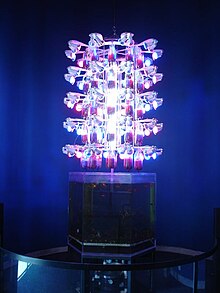Ken Rinaldo
Ken Rinaldo | |
|---|---|
| Born | Kenneth E. Rinaldo 1958 (age 65–66) Queens, New York |
| Nationality | American |
| Alma mater | San Francisco State University, University of California, Santa Barbara |
| Known for | Interactive art installations using technology |
| Website | kenrinaldo |
Kenneth E. Rinaldo (born 1958)[1][2] is an American artist and arts educator, known for his interactive robotics, 3D animation and bio-art installations.
His works include Autopoiesis (2000),[3][4][5] and Augmented Fish Reality (2004), a fish-driven robot.[6]
Biography
Rinaldo was born in Queens and raised in Long Island.[7] He attended Ward Melville High School in Setauket, New York.[7] He moved to California and earned an Associate of Science degree in Computer Science from Cañada College,[7] 1982. He went on to earn a Bachelor of Arts in Communications from The University of California, Santa Barbara;[7] 1984 and a Master of Fine Arts in Conceptual Information Arts from San Francisco State University, 1996.[7] At San Francisco State he studied with artists Steve Wilson, Brian Rogers, George LeGrady and Paul DeMarinis.[7]

In 2000 he received the first prize at the VIDA 3.0 International Artificial Life Competition for Autopoiesis;[8] in 2001 the same piece received an honorable mention at the Ars Electronica Festival.[9][10] In 2004 Rinaldo's Augmented Fish Reality, a fish-driven robot, won an award of distinction at the same festival.[6][11]
Rinaldo directs the Art and Technology Program in the Department of Art at Ohio State University.[10][12]
Further reading
- Shanken, Edward A. (2015). Systems. London: Whitechapel Gallery. [2]
- Reichle, Ingeborg. (2009). Art in the Age of Technoscience: Genetic Engineering, Robotics, and Artificial Life in Contemporary Art. Wien: Springer. [3]
- Shanken, Edward A. (2014). Art and Electronic Media. London: Phaidon Press Limited. [4]
- Brouwer, Joke. (2010) The Politics of the Impure. Rotterdam: NAI. p. 47. [5]
- Ohlenschläger, Karin. (2012) Vida 1999-2012: arte y vida artificial = art and artificial life. Madrid: Fundación Telefónica. [6]
- Parikka, Jussi. (2010) Insect Media: An Archaeology of Animals and Technology. Minneapolis: University of Minnesota Press. p. 134. [7]
- Jones, Noa. (2007) Art in Action: nature, creativity and our collective future. San Rafael: Earth Aware Editions. [8]
- Scarinzi, Alfonsina. (2016) Aesthetics and the embodied mind: beyond art theory and the cartesian mind-body dichotomy. Dordrecht: Springer Netherlands. [9]
- Poissant, Louise, and Daubner, Ernestine. (2005) Art et biotechnologies. Sainte-Foy (Québec): Presses de l'Université du Québec. [10]
- Whitelaw, Mitchell. (2004) Metacreation: Art and Artificial Life. Cambridge, Mass: MIT Press. [11]
- Wilson, Stephen. (2003) Information Arts: Intersections of Art, Science, and Technology. Cambridge, Massachusetts: The MIT press. p. 113. [12]
- Preziosi, Donald. (2007) The Art of Art History: A Critical Anthology. Oxford [u.a.]: Oxford Univ. Press. [13]
- Jones, Amelia. (2006) A Companion to Contemporary Art Since 1945. Malden (MA): Blackwell Publishing. p. 575. [14]
- Aloi, Giovanni. (2012) Art and Animals. London: Tauris. p. 108. [15]
References
- ^ Net, Media Art (2018-02-06). "Rinaldo, Ken: Biography". Media Art Net, medienkunstnetz.de. Retrieved 2018-02-07.
{{cite web}}: Cite has empty unknown parameter:|dead-url=(help) - ^ Gündüz, Mert (2010). "Ken Rinaldo, Boğaziçi - Interview Project". Istanbul Museum. Retrieved 2018-02-07.
{{cite web}}: Cite has empty unknown parameter:|dead-url=(help) - ^ Artificial Life 7 Workshop Proceedings, Carlo C. Maley and Eilis Boudreau Editors, Autopoiesis by Kenneth E. Rinaldo pgs, 166-169
- ^ Information Arts, Intersections of Art, Science, and Technology Stephen Wilson pgs 113-114, 341-342, 344, 427
- ^ Digital Art by Christiane Paul ISBN 978-0-500-20367-5. pg 144, 145
- ^ a b Kenneth Rinaldo and France Cadet: artificial life and the lives of the non-human. (Critical Essay): An article from: Parachute: Contemporary Art Magazine [HTML] (Digital) by Carol Gigliotti pgs 69-83 [1]
- ^ a b c d e f "Interview of Ken Rinaldo". We Make Money Not Art. 2006-08-02. Retrieved 2018-02-07.
- ^ "VIDA 15th Anniversary Celebration". VIDA Fundación Telefónica. Retrieved 2018-02-07.
{{cite web}}: Cite has empty unknown parameter:|dead-url=(help) - ^ "ARCHIVE - Prix Ars Electronica Showcase". archive.aec.at. Retrieved 2018-02-07.
{{cite web}}: Cite has empty unknown parameter:|dead-url=(help) - ^ a b "Ars Electronica Archiv - AUTOPOIESIS". archive.aec.at. Retrieved 2018-02-07.
{{cite web}}: Cite has empty unknown parameter:|dead-url=(help) - ^ "Ars Electronica Archiv". archive.aec.at. Retrieved 2018-02-07.
- ^ Leonardo, Volume 31, number 5, 1998 Technology Recapitulates Phylogeny Artificial Life Art by Kenneth Rinaldo pgs 371-376
